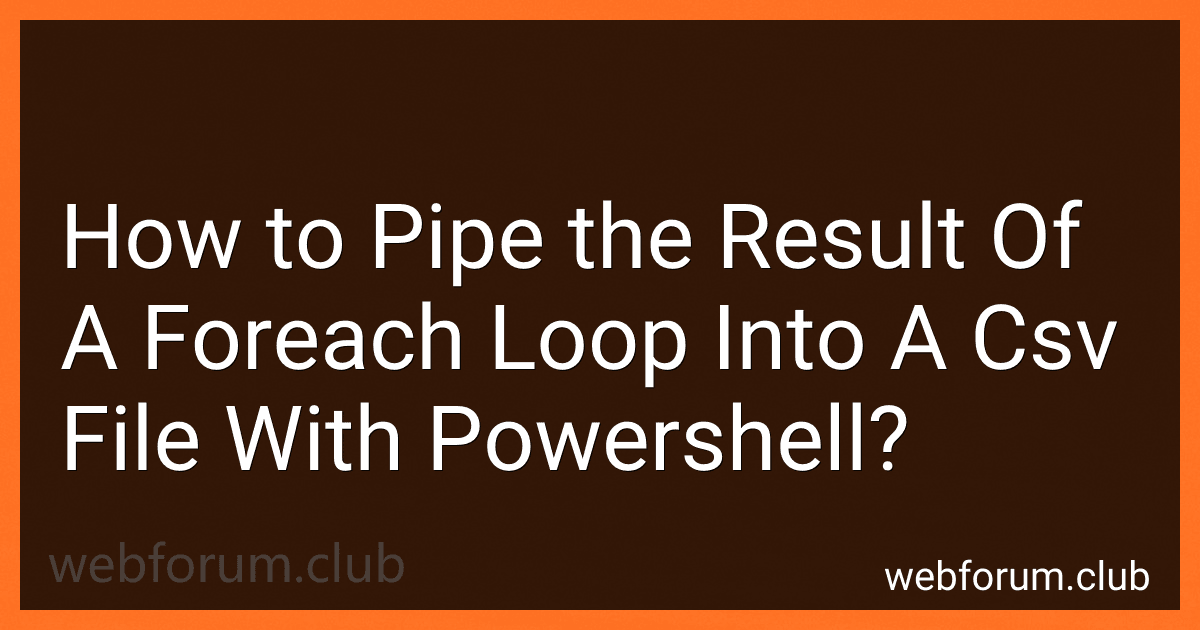To pipe the result of a foreach loop into a CSV file with PowerShell, you can use the Export-Csv cmdlet. Inside your foreach loop, you can output each item to a file using the | symbol followed by Export-Csv and specifying the file path. This will append each item to the CSV file as it goes through the loop, resulting in a CSV file containing all the items processed by the foreach loop.
How to redirect output to a file in PowerShell?
To redirect output to a file in PowerShell, you can use the > or >> operator.
- To overwrite the content of a file, you can use the > operator like this:
command > output.txt
- To append the output to a file, you can use the >> operator like this:
command >> output.txt
Replace command with the actual PowerShell command or script that you want to run and redirect the output to a file named output.txt. Make sure to specify the full file path if the file is not in the current working directory.
How to pipe the result of a foreach loop into a csv file with PowerShell?
You can use the Export-Csv cmdlet in PowerShell to pipe the result of a foreach loop into a CSV file. Here's an example:
# Create an array of objects to loop through $items = @( [PSCustomObject]@{Name='Item1'; Value=100}, [PSCustomObject]@{Name='Item2'; Value=200}, [PSCustomObject]@{Name='Item3'; Value=300} )
Use a foreach loop to process each item
$results = foreach ($item in $items) { # Perform some operations on each item $item.Value = $item.Value * 2 $item }
Pipe the results into a CSV file
$results | Export-Csv -Path 'C:\output.csv' -NoTypeInformation
In this example, we first create an array of objects $items and loop through them using a foreach loop. We then perform some operations on each item and store the results in the $results variable. Finally, we use the Export-Csv cmdlet to export the results into a CSV file named output.csv without including the type information in the output.
How to exclude the type information from a CSV file in PowerShell?
To exclude type information from a CSV file in PowerShell, you can use the Select-Object cmdlet to select only the properties you want to include in the output. Here's an example:
# Import the CSV file $data = Import-CSV "data.csv"
Exclude the type information and select only the properties you want
$data | Select-Object -Property Property1, Property2, Property3 | Export-CSV "output.csv" -NoTypeInformation
In this example, replace "data.csv" with the path to your CSV file and Property1, Property2, Property3 with the names of the properties you want to include in the output. The -NoTypeInformation parameter in the Export-CSV cmdlet will exclude the type information from the output CSV file.
How to overwrite an existing CSV file in PowerShell?
To overwrite an existing CSV file in PowerShell, you can use the Export-Csv cmdlet with the -Force parameter. Here's an example of how to do this:
- Retrieve the data that you want to export to the CSV file.
- Use the Export-Csv cmdlet to overwrite the existing CSV file with the new data. Make sure to use the -Force parameter to overwrite the file.
# Retrieve the data $data = Get-Process
Export the data to the CSV file
$data | Export-Csv -Path "C:\path\to\existingfile.csv" -Force
This command will overwrite the existing CSV file with the new data. Make sure to replace "C:\path\to\existingfile.csv" with the path to your existing CSV file.
